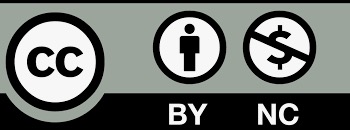Published
2023-07-27
Issue
Section
Research Articles
License
The journal adopts the Attribution-NonCommercial 4.0 International (CC BY-NC 4.0), which means that anyone can reuse and redistribute the materials for non-commercial purposes as long as you follow the license terms and the original source is properly cited.
Author(s) shall retain the copyright of their work and grant the Journal/Publisher rights for the first publication with the work concurrently licensed since 2023 Vol.8 No.2.
Under this license, author(s) will allow third parties to download, reuse, reprint, modify, distribute and/or copy the content under the condition that the authors are given credit. No permission is required from the authors or the publisher.
This broad license intends to facilitate free access, as well as the unrestricted use of original works of all types. This ensures that the published work is freely and openly available in perpetuity.
By providing open access, the following benefits are brought about:
- Higher Visibility, Availability and Citations-free and unlimited accessibility of the publication over the internet without any restrictions increases citation of the article.
- Ease of search-publications are easily searchable in search engines and indexing databases.
- Rapid Publication – accepted papers are immediately published online.
- Available for free download immediately after publication at https://esp.as-pub.com/index.php/ESP

Copyright Statement
1.The authors certify that the submitted manuscripts are original works, do not infringe the rights of others, are free from academic misconduct and confidentiality issues, and that there are no disputes over the authorship scheme of the collaborative articles. In case of infringement, academic misconduct and confidentiality issues, as well as disputes over the authorship scheme, all responsibilities will be borne by the authors.
2. The author agrees to grant the Editorial Office of Environment and Social Psychology a licence to use the reproduction right, distribution right, information network dissemination right, performance right, translation right, and compilation right of the submitted manuscript, including the work as a whole, as well as the diagrams, tables, abstracts, and any other parts that can be extracted from the work and used in accordance with the characteristics of the journal. The Editorial Board of Environment and Social Psychology has the right to use and sub-licence the above mentioned works for wide dissemination in print, electronic and online versions, and, in accordance with the characteristics of the periodical, for the period of legal protection of the property right of the copyright in the work, and for the territorial scope of the work throughout the world.
3. The authors are entitled to the copyright of their works under the relevant laws of Singapore, provided that they do not exercise their rights in a manner prejudicial to the interests of the Journal.
About Licence
Environment and Social Psychology is an open access journal and all published work is available under the Creative Commons Licence, Authors shall retain copyright of their work and grant the journal/publisher the right of first publication, and their work shall be licensed under the Attribution-NonCommercial 4.0 International (CC BY-NC 4.0).
Under this licence, the author grants permission to third parties to download, reuse, reprint, modify, distribute and/or copy the content with attribution to the author. No permission from the author or publisher is required.
This broad licence is intended to facilitate free access to and unrestricted use of original works of all kinds. This ensures that published works remain free and accessible in perpetuity. Submitted manuscripts, once accepted, are immediately available to the public and permanently accessible free of charge on the journal’s official website (https://esp.as-pub.com/index.php/ESP). Allowing users to read, download, copy, print, search for or link to the full text of the article, or use it for other legal purposes. However, the use of the work must retain the author's signature, be limited to non-commercial purposes, and not be interpretative.
Click to download <Agreement on the Licence for the Use of Copyright on Environmental and Social Psychology>.
How to Cite
Psychological well-being is aligned to the ethical theory of flourishing
Petrina Coventry
Adelaide University, South Australian Health and Medical Research Institute (SAHMRI)
DOI: https://doi.org/10.54517/esp.v8i2.1603
Keywords: anxiety, emotion, agency, responsibility, self determination
Abstract
Flourishing, an ethical theory founded in Stoic philosophy, centers around emotional control and learning how to live well. It connects strongly with the modern construct of psychological well-being (PWB). PWB programs are increasingly included in workplaces and factors contributing to their success can include individual motivations, accountability and responsibility, organizational support systems and design, and an understanding of mental health conditions. Anxiety, the most commonly experienced mental health condition, is an emotional state that can directly affect PWB, yet it is often neglected in research, as is the concept of who is responsible for PWB. This paper outlines a study to test the hypotheses that: emotional states can affect PWB: emotion can be considered an ethical construct; improving PWB benefits both individuals and organizations and that shared responsibility can optimize organizational PWB program outcomes. Existing information was gathered from a systematic literature review and new information was gathered from a study conducted with the Australian Institute of Health and Safety (AIHS). Mixed method research incorporated quantitative and qualitative data collection, testing occupational health and safety (OHS) practitioners’ views on anxiety, and perceptions of factors affecting success or failure of PWB programs. Findings included strong indications that: anxiety can affect PWB and impact performance and productivity; shared responsibility between employees and organizations may improve the outcomes for PWB programs; information and education around self-care, and motivational principles connected to virtue ethics can all assist individuals and organizations to assume responsibility for their role with PWB initiatives.References
[1]. Schmidt B, Schneider M, Seeger P, et al. A comparison of job stress models: Associations with employee well-being, absenteeism, presenteeism, and resulting costs. Journal of Occupational and Environmental Medicine 2019; 61(7): 535. doi: 10.1097/JOM.0000000000001582
[2]. Biddle N. Behavioural Economics and the COVID-Induced Education Crisis. OECD Publishing; 2021.
[3]. Monistrol-Mula A, Felez-Nobrega M, Domènech-Abella J, et al. The impact of COVID-related perceived stress and social support on generalized anxiety and major depressive disorders: Moderating effects of pre-pandemic mental disorders. Annals of General Psychiatry 2022; 21(1): 7.
[4]. Bandelow B, Michaelis S, Wedekind D. Treatment of anxiety disorders. Dialogues in Clinical Neuroscience 2017; 19(2): 93. doi: 10.31887/DCNS.2017.19.2/bbandelow
[5]. Karanika-Murray M. Derailed Organizational Interventions for Stress and Well-Being Confessions of Failure and Solutions for Success. Springer; 2015.
[6]. Fan D, Zhu CJ, Timming AR, et al. Using the past to map out the future of occupational health and safety research: Where do we go from here? The International Journal of Human Resource Management: Annual Review, Guest Editors: Emma Parry, Michael Dickmann& Fang Lee Cooke 2020; 31(1): 90–127. doi: 10.1080/09585192.2019.1657167
[7]. Weaver B, Kirk-Brown A, Goodwin D, et al. Psychosocial safety behavior: A scoping review of behavior-based approaches to workplace psychosocial safety. Journal of Safety Research 2023; 84: 33–40. doi: 10.1016/j.jsr.2022.10.006
[8]. Baicker K, Cutler D, Song Z. Workplace wellness programs can generate savings. Health Affairs (Project Hope) 2010; 29(2): 304–311. doi: 10.1377/hlthaff.2009.0626
[9]. Eysenck MW, Calvo MG. Anxiety and performance: The processing efficiency theory. Cognition and Emotion 1992; 6(6): 409–434. doi: 10.1080/02699939208409696
[10]. Wilson M. From processing efficiency to attentional control: A mechanistic account of the anxiety-performance relationship. International Review of Sport and Exercise Psychology 2008; 1(2): 184–201. doi: 10.1080/17509840802400787
[11]. Khazaei S, Amin MR, Faghih RT. Decoding a Neurofeedback-Modulated Cognitive Arousal State to Investigate Performance Regulation by the Yerkes-Dodson Law. IEEE.
[12]. Aon. Health and wwellbeing survey. Available online: https://www.aon.com/global-wellbeing-survey (accessed on 27 July 2023).
[13]. Marciniak M, Lage MJ, Landbloom RP, et al. Medical and productivity costs of anxiety disorders: Case control study. Depression and Anxiety 2004; 19(2): 112–120. doi: 10.1002/da.10131
[14]. Lingard H, Wakefield R, Cashin P. The development and testing of a hierarchical measure of project OHS performance. Engineering, Construction, and Architectural Management 2011; 18(1): 30–49.
[15]. Lerouge L. Psychosocial Risks in Labour and Social Security Law: A Comparative Legal Overview from Europe, North America, Australia and Japan. Springer International Publishing; 2017.
[16]. Michael T, Nicholas B. Employment law: Improving wellness in the workplace: Think holistically and beyond. Governance Directions 2016; 68(8): 497–499.
[17]. Potter R, O’Keeffe V, Leka S, et al. Analytical review of the Australian policy context for work-related psychological health and psychosocial risks. Safety Science 2019; 111: 37–48. doi: 10.1016/j.ssci.2018.09.012
[18]. Kevin A. Employers need guidance on psychosocial hazards, says minister. Lamp 2021; 78(3): 26–27.
[19]. Soldatova G, Rasskazova E. Anxiety of pandemic and distance learning as predictor of decrease in satisfaction, competence and engagement in students during digital education period. European Psychiatry 2022; 65(S1): S341. doi: 10.1192/j.eurpsy.2022.867
[20]. do Prado CB, Emerick GS, Cevolani Pires LB, et al. Impact of long-term COVID on workers: A systematic review protocol. PloS One 2022; 17(9): e0265705–e0265705. doi: 10.1371/journal.pone.0265705
[21]. Li K, Griffin MA. Safety behaviors and job satisfaction during the pandemic: The mediating roles of uncertainty and managerial commitment. Journal of Safety Research 2022; 82: 166–175. doi: 10.1016/j.jsr.2022.05.008
[22]. Gallagher C, Underhill E, Rimmer M. Occupational safety and health management systems in Australia: Barriers to success. Policy and Practice in Health and Safety 2003; 1(2): 67–81. doi: 10.1080/14774003.2003.11667637
[23]. Brien M, Hass C, Savoie A. Psychological health as a mediator between need satisfaction at work and teachers’ self-perceptions of performance. Canadian Journal of Behavioural Science 2012. 44(4): 288–299. doi: 10.1037/a0028056
[24]. Lin PT, Vu TT, Nguyen VP, et al. Self-determination theory and accountant employees’ psychological wellbeing: The roles of positive affectivity and psychological safety. Frontiers in Psychology 2022; 13: 870771–870771. doi: 10.3389/fpsyg.2022.870771
[25]. Roberge V, Boudrias JS. The moderating role of employees’ psychological strain in the empowering leadership—Proactive performance relationship. International Journal of Stress Management 2021; 28(3): 186–196. doi: 10.1037/str0000221
[26]. Knouse LE, Cooper-Vince C, Sprich S, et al. Recent developments in the psychosocial treatment of adult ADHD. Expert Review of Neurotherapeutics 2008; 8(10): 1537–1548. doi: 10.1586/14737175.8.10.1537
[27]. Schmutte PS, Ryff CD. Personality and well-being: Reexamining methods and meanings. Journal of Personality and Social Psychology 1997; 73(3): 549–559. doi: 10.1037/0022-3514.73.3.549
[28]. Panaccio A, Vandenberghe C. Perceived organizational support, organizational commitment and psychological well-being: A longitudinal study. Journal of Vocational Behavior 2009. 75(2): 224–236. doi: 10.1016/j.jvb.2009.06.002
[29]. Diener E, Suh E. Measuring quality of life: Economic, social, and subjective indicators. Social Indicators Research 1997; 40: 189–216.
[30]. Rothbaum BOE. Pathological Anxiety: Emotional Processing in Etiology and Treatment. Guilford Press; 2006.
[31]. Klausen SH. Ethics, knowledge, and a procedural approach to wellbeing. Inquiry (Oslo) 2023; 66(1): 31–47. doi: 10.1080/0020174X.2018.1529619
[32]. Birnbaum HG, Kessler RC, Kelley D, et al. Employer burden of mild, moderate, and severe major depressive disorder: Mental health services utilization and costs, and work performance. Depression and Anxiety 2010; 27(1): 78–89. doi: 10.1002/da.20580
[33]. Svensson F. Happiness, wellbeing, and their relation to virtue in Descartes’ ethics. Theoria (Lund, Sweden) 2011; 7(3): 238–260. doi: 10.1111/j.1755-2567.2011.01101.x
[34]. Badhwar NK. Well-being: Happiness in a Worthwhile Life. Oxford University Press; 2014.
[35]. Koehn D. Why We Need a New (Old) Idea of Responsibility. Springer International Publishing AG; 2019. pp. 1–8.
[36]. Ryan RM. Self-Determination Theory: Basic Psychological Needs in Motivation, Development, and Wellness. The Guilford Press; 2017.
[37]. Wehmeyer ML, Shogren KA, Little TD, Lopez SJ. Development of Self-Determination through the Life-Course. Springer Netherlands; 2017.
[38]. Shogren KA, Raley SK. Self-Determination and Causal Agency Theory: Integrating Research into Practice. Springer International Publishing AG; 2022.
[39]. Schirmer W, Michailakis D. The responsibility principle. Contradictions of priority-setting in Swedish healthcare. Acta Sociologica 2011; 54(3): 267–282. doi: 10.1177/0001699311412624
[40]. Blaxter M. Whose fault is it? People’s own conceptions of the reasons for health inequalities. Social Science & Medicine 1997; 44(6): 747–756. doi: 10.1016/S0277-9536(96)00192-X
[41]. De Vries GJ. Marginal notes on Plato’s symposium. Mnemosyne 1980; 33(3–4): 349–351.
[42]. Moskop JC, Kopelman LM. Ethics and Critical Care Medicine, 1st ed. Springer Dordrecht; 1985.
[43]. Devisch I. Co-responsibility: A new horizon for today’s health care? Health Care Analysis 2012; 20(2): 139–151.
[44]. Siltaniemi A, Kauppinen ML. The view from the international council on social welfare. European Journal of Social Quality 2005; 5(1–2): 275–288. doi: 10.3167/146179105780337440
[45]. Alladin A. The wounded self: New approach to understanding and treating anxiety disorders. American Journal of Clinical Hypnosis 2014; 56(4): 368–388. doi: 10.1080/00029157.2014.880045
[46]. Obeidat MS, Sarhan LO, Qasim TQ. The influence of human resource management practices on occupational health and safety in the manufacturing industry. International Journal of Occupational Safety and Ergonomics 2022; 1–15. doi: 10.1080/10803548.2022.2120267
[47]. Van De Voorde K, Beijer S. The role of employee HR attributions in the relationship between high-performance work systems and employee outcomes. Human Resource Management Journal 2015; 25(1): 62–78. doi: 10.1111/1748-8583.12062
[48]. Beijer SE. HR Practices at Work: Their Conceptualization and Measurement in HRM Research. Gildeprint; 2014.
[49]. Veld M, Alfes K. HRM, climate and employee well-being: Comparing an optimistic and critical perspective. The International Journal of Human Resource Management 2017; 28(16): 2299–2318. doi: 10.1080/09585192.2017.1314313
[50]. Geisler M, Berthelsen H, Muhonen T. Retaining social workers: The role of quality of work and psychosocial safety climate for work engagement, job satisfaction, and organizational commitment. Human Service Organizations: Management, Leadership & Governance 2019; 43(1): 1–15. doi: 10.1080/23303131.2019.1569574
[51]. Fan J, Litchfield RC, Islam S, et al. Workplace social self-efficacy: Concept, measure, and initial validity evidence. Journal of Career Assessment 2013; 21(1): 91–110. doi: 10.1177/1069072712454702
[52]. Beaton EE, DeJordy R, Foster P. The lived experience of managerialization: Understanding values conflict in non-profits through a pragmatic institutionalism. Journal of Management Studies 2021; 58(6): 1471–1506. doi: 10.1111/joms.12661
[53]. Jamal, K, Bowie NE. Theoretical considerations for a meaningful code of professional ethics. Journal of Business Ethics 1995; 14(9): 703–714.
[54]. Denzin NK. The Sage Handbook of Qualitative Research, 4th ed. In: Denzin NK, Lincoln YS (editors). Sage; 2011.
[55]. Jamshed S. Qualitative research method-interviewing and observation (editorial). Journal of Basic and Clinical Pharmacy 2014; 5(4): 87. doi: 10.4103/0976-0105.141942
[56]. Cote L, Turgeon J. Appraising qualitative research articles in medicine and medical education. Medical Teacher 2005; 27(1): 71–75. doi: 10.1080/01421590400016308
[57]. Halcomb E, Fernandez RS. Systematic reviews. Nursing Standard 2015; 29(33): 45.
[58]. Guba EG, Lincoln YS. Fourth Generation Evaluation. Sage Publications; 1989.
[59]. Nowell LS, Norris JM, White DE, et al. Thematic analysis: Striving to meet the trustworthiness criteria. International Journal of Qualitative Methods 2017; 16(1). doi: 10.1177/1609406917733
[60]. Shantz A, Alfes K, Latham GP. The buffering effect of perceived organizational support on the relationship between work engagement and behavioral outcomes. Human Resource Management 2016; 55(1): 25–38. doi: 10.1002/hrm.21653
[61]. Brulé J. A causation coefficient and taxonomy of correlation/causation relationships. arXiv 2017; arXiv:1708.05069. doi: 10.48550/arXiv.1708.05069
[62]. Bouzikos S, Afsharian A, Dollard M, et al. Contextualising the effectiveness of an employee assistance program intervention on psychological health: The role of corporate climate. International Journal of Environmental Research and Public Health 2022; 19(9): 5067. doi: 10.3390/ijerph19095067
[63]. Spence GB. Workplace wellbeing programs: If you build it they may NOT come…because it’s not what they really need! International Journal of Wellbeing 2015; 5(2): 109–124. doi: 10.5502/ijw.v5i2.7
[64]. Sorenson RD. Stress management in education: Warning signs and coping mechanisms. Management in Education 2007; 21(3): 10–13. doi: 10.1177/0892020607079985
[65]. Chisholm D, Sweeny K, Sheehan P, et al. Scaling-up treatment of depression and anxiety: A global return on investment analysis. The Lancet Psychiatry 2016; 3(5): 415–424. doi: 10.1016/S2215-0366(16)30024-4
[66]. Naydeck BL, Pearson JA, Ozminkowski RJ, et al. The impact of the highmark employee wellness programs on 4-year healthcare costs. Journal of Occupational and Environmental Medicine 2008; 50(2): 146–156.
[67]. Riba MB, Parikh SV, Greden JF (editors). Mental Health in the Workplace: Strategies and Tools to Optimize Outcomes (Integrating Psychiatry and Primary Care), 1st ed. Springer; 2019.







